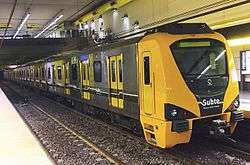Buenos Aires Underground 300 Series
| 300 Series | |
|---|---|
|
A 300 Series train on Line H undergoing tests before its introduction. | |
| Manufacturer | Alstom |
| Family name | Alstom Metropolis |
| Constructed | 2015- |
| Entered service | 2016 |
| Number built |
|
| Number in service | 36+ |
| Formation | 6 cars per trainset |
| Operator(s) | Buenos Aires Underground |
| Line(s) served |
|
| Specifications | |
| Car body construction | Stainless steel |
| Car length | 17m |
| Width | 2.6m |
| Doors | 4 per side |
| Power supply | 1500v |
| Track gauge | 1,435 mm (4 ft 8 1⁄2 in) |
The 300 Series are a number of underground cars manufactured by Alstom in Brazil for use on the Buenos Aires Underground. They are used on Line H of the network, and more are to be introduced on Line D where they will serve alongside the similar 100 Series.
History
.jpg)
The 300 Series cars were initially ordered for Line H in 2012 with an initial order of 120 cars at a cost of US$ 216 million. These were to be delivered in 2015 and produced solely in Alstom's plant in Sao Paolo, unlike the 100 Series which also had components produced in Argentina.[1] These were to be put into service once Córdoba, Santa Fe and Las Heras stations were opened.[2]
On Line H, the cars replaced the Siemens-Schuckert Orenstein & Koppel cars which had served on every line of the system, with the exception of Line B at different times since 1934. When the line was originally opened, it was not deemed necessary to purchase new stock until it had been extended enough and passenger numbers were at a level where new rolling stock was warranted, thus the Siemens O&K cars were brought out of retirement temporarily. In July 2016, 36 of the Alstom cars were put into service on Line H, retiring the Siemens cars, while the remaining cars and those for Line D are set to be put into service gradually until 2017.[3][4]
In late 2014, the order was expanded by 50% to include an additional 60 cars for Line D in order to replace the ageing Fiat-Materfer cars built in the early 1980s. Unlike Line H, whose entire fleet would consist of the 300 series, in Line D the cars are to serve alongside the 100 Series, which are also Alstom Metropolis cars and bear similarities.[5]
Characteristics
The cars are designed to work with Communication Based Train Control (CBTC) in order to ensure a better frequency on the lines.[6] They come installed with security cameras, audio warnings for approaching stations and are accessible to the disabled.[7]
The cars also have air conditioning and a system to prevent cars from stacking atop one another in the event of a collision, as well as being equipped with black boxes in the conductor's cabins.[8]
Gallery
 First cars being loaded into Line H
First cars being loaded into Line H The 300 series replaced the aged Siemens O&K cars
The 300 series replaced the aged Siemens O&K cars The 100 Series bares many resemblances to the 300 series
The 100 Series bares many resemblances to the 300 series.jpg) A train on Line H
A train on Line H Mayor Horacio Rodriguez Larreta on the inaugural trip
Mayor Horacio Rodriguez Larreta on the inaugural trip
See also
| Wikimedia Commons has media related to 300 Series (Buenos Aires Metro). |
- Buenos Aires Underground rolling stock
- Alstom Metropolis
- Buenos Aires Underground 100 Series
- Buenos Aires Underground 200 Series
References
- ↑ "La Ciudad toma deuda para comprar 120 coches Alstom para la línea H". EnElSubte (in Spanish). 10 May 2013. Retrieved 6 July 2016.
- ↑ "Licitan inspección técnica de coches Alstom para la línea H". EnElSubte (in Spanish). 16 January 2015. Retrieved 6 July 2016.
- ↑ "Reabrió la línea H y los pasajeros se quejan por la frecuencia". EnElSubte (in Spanish). 4 July 2016. Retrieved 7 July 2016.
- ↑ "El último viaje de los Siemens en la línea H". EnElSubte (in Spanish). 3 July 2016. Retrieved 7 July 2016.
- ↑ "La Ciudad coloca deuda para comprar 60 coches Alstom para la línea D". EnElSubte (in Spanish). 28 January 2016. Retrieved 6 July 2016.
- ↑ "Los 6 cambios que traen los nuevos subtes de la línea H". La Nacion. Retrieved 7 July 2016.
- ↑ "Los 6 cambios que traen los nuevos subtes de la línea H". La Razon. Retrieved 7 July 2016.
- ↑ "Mañana entran en funcionamiento los nuevos trenes automáticos de la línea H - Perfil.com". Perfil (in Spanish). Retrieved 7 July 2016.
